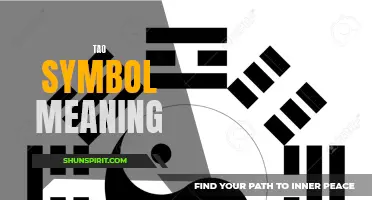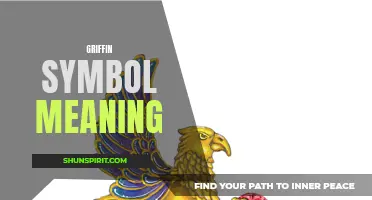
Turkey is a country rich in culture and history, and its symbols reflect this diverse heritage. From the crescent and star on the national flag to the eye that wards off evil, Turkish symbols are filled with deep meanings and stories. These symbols not only serve as a source of national pride but also connect the past with the present, bridging generations and uniting people across the country. In this article, we will explore some of the most fascinating Turkish symbols and unravel the secrets behind their significance. Prepare to be enchanted by the allure of Turkish tradition as we delve into the world of symbols and their hidden meanings.
What You'll Learn
- What is the significance of the crescent and star symbol in Turkish culture?
- What are some other commonly recognized symbols in Turkish art and design?
- How do Turkish symbols and their meanings differ from symbols in other cultures?
- Are there any specific symbols in Turkish folklore or mythology that hold special meaning?
- How have Turkish symbols and their meanings evolved over time?

What is the significance of the crescent and star symbol in Turkish culture?
The crescent and star symbol is one of the most recognizable symbols associated with Turkey. It has deep significance in Turkish culture and represents various historical and cultural aspects of the country.
The origin of the crescent and star symbol can be traced back to the early years of the Turkish nation. It is believed that the symbol was adopted during the reign of the Ottoman Empire in the 15th century. The use of the crescent and star has been associated with Islam, which is the predominant religion in Turkey. The crescent is commonly associated with the moon, and the star reflects the Islamic belief in the divine presence.
In Islamic tradition, the crescent and star hold a spiritual meaning. The crescent represents new beginnings, growth, and enlightenment. It symbolizes the concept of renewal and the passage of time. The moon regularly goes through phases, and each phase represents a different cycle of life. Similarly, the star is seen as a guiding light, leading people on the right path and providing hope and inspiration.
The crescent and star symbol in Turkish culture also has historical significance. During the Ottoman Empire, the symbol was prominently displayed on the flag of the empire. It became a symbol of Turkish identity and was associated with the power, prestige, and grandeur of the empire. The Ottoman Empire was one of the largest and longest-lasting empires in history, and the crescent and star became synonymous with its rule.
Today, the crescent and star symbol is present in various aspects of Turkish culture. It can be seen on the Turkish flag, which has a red background with a white crescent and star in the center. The symbol is also commonly used in architecture, particularly in mosques and other religious buildings. It is often incorporated into decorative elements, such as tiles, carpets, and calligraphy.
Furthermore, the crescent and star symbol is used in commercial and branding purposes in Turkey. Many Turkish companies use the symbol in their logos, representing their Turkish heritage and appealing to a sense of national pride. It has also been used in tourism campaigns to promote Turkey as a cultural and historical destination.
In conclusion, the crescent and star symbol holds great significance in Turkish culture. It represents the country's Islamic heritage, historical legacy, and national identity. The symbol has become an iconic representation of Turkey and is deeply ingrained in the country's cultural and religious traditions.
The Meaning and Symbolism of Fern: A Guide to Nature's Intricate Plant
You may want to see also

What are some other commonly recognized symbols in Turkish art and design?
Turkish art and design are known for their intricate and beautiful symbols that are deeply rooted in the country's history and culture. These symbols can be seen in various forms of art, architecture, textiles, and even everyday objects.
One commonly recognized symbol in Turkish art and design is the evil eye, also known as the Nazar Boncugu. This symbol is believed to protect against jealousy and bad luck. It is often depicted as a blue, circular charm with a white and blue dot in the center. The evil eye can be found on everything from jewelry and clothing to home decor and souvenirs.
Another symbol that is frequently used in Turkish art and design is the tulip. The tulip is native to Turkey and holds great significance in Turkish culture. It is often associated with love and beauty. In Ottoman times, the tulip became a symbol of wealth and power and was widely used in various art forms. Today, it can be seen in traditional Ottoman patterns as well as modern designs.
The star and crescent symbol is another iconic image in Turkish art and design. It is often associated with Islam and can be found on the Turkish flag. The star and crescent symbol also represents openness and unity, reflecting Turkey's history as a bridge between Europe and Asia. It is commonly used in Turkish textiles and jewelry.
The tree of life is another symbol that is frequently depicted in Turkish art. It symbolizes the connection between heaven and earth and is believed to bring good luck and prosperity. The tree of life can be seen in various forms, such as paintings, carvings, and embroidery, and is often adorned with colorful flowers and birds.
Other commonly recognized symbols in Turkish art and design include the pomegranate, which symbolizes fertility and abundance, and the hand of Fatima, which is believed to protect against evil spirits and bring good luck.
In conclusion, Turkish art and design are filled with a variety of symbols that represent different aspects of the country's culture and history. These symbols not only serve as decorative elements but also carry deep meanings and beliefs. Whether it is the evil eye, the tulip, or the star and crescent symbol, Turkish art and design are sure to captivate and inspire with their rich symbolism.
Exploring the Sacred Art: Indonesian Tattoo Symbols and Their Profound Meanings
You may want to see also

How do Turkish symbols and their meanings differ from symbols in other cultures?
Symbols have been an integral part of human culture for centuries. They have been used to convey meaning, tell stories, and represent deep-rooted beliefs. Turkish symbols, like symbols from other cultures, carry their own unique meanings that differentiate them from symbols in other cultures.
One widely recognized Turkish symbol is the "evil eye" or "nazar boncugu." This symbol is believed to protect against the "evil eye," which is thought to bring bad luck or harm. The evil eye symbol is commonly depicted as a blue eye-shaped amulet and is believed to have the power to ward off negative energy and protect the wearer from harm. This symbol is deeply ingrained in Turkish culture and is often seen in homes, businesses, and even worn as fashion accessories. In contrast, symbols in other cultures may vary in their purpose and interpretations.
Another significant Turkish symbol is the "crescent and star." This symbol is prominently featured on the Turkish flag and is often associated with Islam. The crescent and star symbolize the Ottoman Empire, which once ruled a vast area of the world, including Turkey. The crescent represents the new moon, symbolizing rebirth and beginnings, while the star represents guidance and enlightenment. While this symbol may have different meanings in other cultures, in Turkish culture, it represents the nation's history and heritage.
Turkish culture also incorporates symbols inspired by nature and animals. The "Tulip" is a symbol that holds great significance in Turkish history. In the Ottoman Empire, the tulip was highly cherished and became a symbol of wealth and power. Today, the tulip is often associated with Istanbul and is celebrated during the annual Istanbul Tulip Festival. Other animal symbols in Turkish culture include the "Mevlana's Whirling Dervishes," which symbolize the spiritual journey and connection with God, and the "Wolf," which represents courage, loyalty, and protection.
In comparison, symbols in other cultures may have different meanings and associations. For example, the lotus flower is a widely recognized symbol in various Asian cultures. In Buddhism, the lotus symbolizes purity and enlightenment, while in Hinduism, it represents beauty and fertility. The lotus flower can be interpreted differently in different cultures, highlighting the diversity and complexity of symbolism across different societies.
Symbols play a significant role in shaping cultures and societies. They act as a visual language that carries meanings and values from one generation to another. Turkish symbols, with their unique meanings and interpretations, represent the rich history, beliefs, and traditions of Turkish culture. Understanding these symbols allows us to appreciate the diversity and beauty that symbolism adds to our world.
Decoding Caterpillar Warning Symbols: What Do They Mean and How to Respond
You may want to see also

Are there any specific symbols in Turkish folklore or mythology that hold special meaning?
Turkish folklore and mythology are filled with symbols that hold special meaning. These symbols are often used to represent cultural beliefs, values, and traditions. They can be found in various forms, including animals, objects, and natural elements. In this article, we will explore some of the most significant symbols in Turkish folklore and mythology.
The Evil Eye: Perhaps one of the most well-known symbols in Turkish folklore is the evil eye, also known as "Nazar Boncugu." This symbol is believed to protect against negative energy and bring good luck. The evil eye is typically depicted as a blue and white disc with a blue center representing an eye. It is often worn as a talisman or hung in homes and vehicles as a protective amulet.
The Wolf: In Turkish mythology, the wolf holds a significant place. It is seen as a powerful and wise creature. Wolves are believed to symbolize strength, loyalty, and guardianship. In many folk tales, they are portrayed as protectors and helpers of the weak. The wolf is also associated with independence and freedom.
The Tree of Life: Another important symbol in Turkish folklore is the Tree of Life. This symbol represents the connection between heaven, earth, and the underworld. It is often depicted as a tall, straight tree with branches reaching towards the sky and roots extending deep into the earth. The Tree of Life is seen as a source of wisdom, fertility, and spiritual growth.
The Falcon: The falcon is a symbol of power and courage in Turkish folklore. It represents freedom, agility, and the ability to see beyond appearances. Falcons are often associated with divine intervention and are considered messengers between the mortal world and the gods. They are also believed to possess healing powers and are highly respected and revered.
The Crescent Moon and Star: The crescent moon and star are internationally recognized symbols of Islam, but they also hold significance in Turkish folklore and mythology. These symbols are believed to bring protection, guidance, and enlightenment. The moon represents femininity, intuition, and the rhythm of life, while the star represents hope, guidance, and divinity.
The Dragon: The dragon is a mythical creature that appears in Turkish folklore and mythology. It is often depicted as a serpent-like creature with wings and is associated with power, wisdom, and protection. Dragons are believed to guard treasures, knowledge, and sacred places. They are also seen as symbols of transformation and rebirth.
These are just a few examples of the symbols found in Turkish folklore and mythology. Each symbol carries its own unique meaning and significance, contributing to the rich cultural heritage of Turkey. They serve as a reminder of the values, beliefs, and traditions passed down through generations. Whether displayed as decorative elements or used in storytelling, these symbols continue to play an essential role in Turkish culture.
Decoding the Enigmatic Berber Symbols: Unraveling Their Deep Meanings
You may want to see also

How have Turkish symbols and their meanings evolved over time?
Symbols play a significant role in Turkish culture and society. They are used to express ideas, beliefs, and values, and have evolved over time to reflect the changing Turkish identity. These symbols not only hold historical and cultural significance but also contribute to the rich tapestry of Turkish heritage.
One of the most recognizable symbols in Turkish culture is the crescent moon and star. This symbol dates back centuries and has been associated with the Turks since the time of the Ottoman Empire. Initially, it was used to represent the empire itself, with the crescent moon symbolizing Islam and the star representing the Turks' connection to the heavens. Over time, the crescent moon and star became widely recognized as a symbol of Turkey and the Turkish identity.
Another symbol that has evolved over time is the national flag of Turkey. Adopted in 1844, the flag consisted of a red field with a white star and crescent in the center. However, in 1936, the star on the flag was changed from a six-pointed star to a five-pointed star, and the design has remained the same since then. This change was made to symbolize the transition from the Ottoman Empire to the modern Turkish Republic and to embrace a more inclusive symbol.
In addition to these national symbols, there are also regional and cultural symbols that are specific to different areas of Turkey. These symbols often reflect the local history, traditions, and natural environment of each region. For example, the tulip flower is considered a symbol of Istanbul and is widely associated with the city's beauty and charm. The Evil Eye, a blue eye-shaped amulet, is another powerful symbol in Turkish culture that is believed to protect against evil and bring good luck.
Symbols in Turkish culture have also been influenced by historical events and political ideologies. For instance, during the Republican era, symbols associated with the Ottoman Empire were replaced with those representing the values and principles of the new republic. The national emblem, known as the "Six Arrows," represents the six foundational principles of the Republic: republicanism, nationalism, populism, statism, secularism, and revolutionism. This emblem has become an important symbol of modern Turkey and its democratic values.
Moreover, symbols such as the Turkish flag and the star and crescent have also been used in political movements and demonstrations throughout history. During times of political turmoil, these symbols have served as rallying points for Turks to express their unity, strength, and defiance against adversity. They have become powerful symbols of national pride and identity, representing the resilience and determination of the Turkish people.
In conclusion, Turkish symbols and their meanings have evolved over time to reflect the changing Turkish identity. From ancient emblems of the Ottoman Empire to modern symbols of the Turkish Republic, these symbols have played an essential role in expressing the values, beliefs, and aspirations of the Turkish people. Whether it is the crescent moon and star, the national flag, or regional and cultural symbols, they all contribute to the rich tapestry of Turkish heritage and serve as powerful reminders of the country's history and its people's spirit.
Understanding the Symbolism Behind the Jainism Symbol
You may want to see also
Frequently asked questions
Answer 1: The Turkish evil eye symbol, also known as the Nazar Boncugu, is a protective talisman believed to protect against the evil eye, which is a curse caused by jealousy or envy. It is a widely recognized symbol in Turkish culture and is often used as a decorative element in jewelry, home decor, and clothing.
Question 2: What is the significance of the crescent and star symbol in Turkish culture?
Answer 2: The crescent and star symbol is commonly associated with Turkish culture and is seen on the flag of Turkey. The crescent symbolizes the moon, which is an important religious symbol in Islam, and the star represents guidance and protection. This symbol has deep historical and cultural significance in Turkey and is often used to represent Turkish identity and heritage.
Question 3: What does the "Hand of Fatima" symbol represent in Turkish culture?
Answer 3: The "Hand of Fatima," also known as the Hamsa or Hand of Fatima, is a popular symbol in Turkish culture. It is believed to offer protection against the evil eye and bring good luck. The symbol features an open right hand, often with an eye in the center, and is frequently used in jewelry, amulets, and home decor.
Question 4: What is the meaning of the Turkish tulip symbol?
Answer 4: The tulip is an ancient symbol that holds special significance in Turkish culture. It is considered the national flower of Turkey and symbolizes abundance, prosperity, and beauty. The Turkish tulip symbol can be found in various forms of art, including pottery, textiles, and architecture, and is often associated with the Ottoman Empire. The tulip motif is highly regarded in Turkish design and is commonly used in traditional Turkish patterns.







